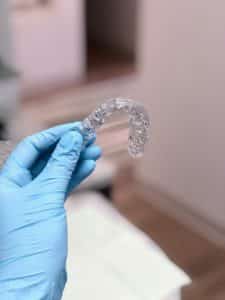 You have a headache … again. It’s the third day in a row you’ve woken up with one. It’s become far too common, and you wish it would stop. Either way, you take a few pain relievers before getting started on the rest of your morning routine.
You decide to swing by a coffee shop on the way to work. You grab a breakfast sandwich to go with your coffee. That was your plan, at least. After a few bites of your sandwich, you notice your jaw feels awfully sore. You try to eat more, but just trying to chew makes it worse.
The headaches and jaw pain could be unrelated. Then again, they could both be symptoms of a TMJ disorder. If so, then you may want to schedule a visit to River Oaks Dental. Dr. Rachel Monteiro and our team in Jacksonville, FL could help you treat the cause of your condition so you can wake up pain-free and enjoy a pain-free breakfast again — whatever you want to eat.
Call 904-348-0416 now to schedule a consultation.
You have a headache … again. It’s the third day in a row you’ve woken up with one. It’s become far too common, and you wish it would stop. Either way, you take a few pain relievers before getting started on the rest of your morning routine.
You decide to swing by a coffee shop on the way to work. You grab a breakfast sandwich to go with your coffee. That was your plan, at least. After a few bites of your sandwich, you notice your jaw feels awfully sore. You try to eat more, but just trying to chew makes it worse.
The headaches and jaw pain could be unrelated. Then again, they could both be symptoms of a TMJ disorder. If so, then you may want to schedule a visit to River Oaks Dental. Dr. Rachel Monteiro and our team in Jacksonville, FL could help you treat the cause of your condition so you can wake up pain-free and enjoy a pain-free breakfast again — whatever you want to eat.
Call 904-348-0416 now to schedule a consultation.
TMJ 101
TMJ is an abbreviation for temporomandibular joint. You have two of these joints. They are ball-and-socket joints that connect your lower jaw (or mandible) to your skull. They allow you to open and close your mouth. To find these joints, place a hand on each side of your face, just below your ears. Now, open and close your mouth. You should feel them moving. When you have a TMJ disorder (or TMD), you generally have a problem with one or both joints or the muscle tissue connected to the joints. This can affect you in a variety of ways. You may notice one or more of the following symptoms:- Frequent headaches or earaches
- Jaw pain
- Limited jaw movement, including feeling like your jaw is stuck
- Pain in your jaw or face while eating or after meals
- Clicking or popping when you open or close your mouth
- Pain in your face
- Pain in your neck, upper back, and/or shoulders
TREATING TEETH GRINDING
When you visit us, Dr. Monteiro can examine your teeth for the signs of grinding. It may go without saying, but grinding down the enamel of your teeth is bad for your oral health. The pressure from clenching can cause teeth to crack. The pressure can leave you more likely to develop cavities and gum disease as well. If you are teeth grinder, we can help in two ways. One option is an occlusal adjustment. This is done by contouring teeth so your bite fits together more comfortably. The second option is making a custom-fitted night guard. This acts as a protective barrier between your top and bottom teeth. It can relieve the pressure on your joint, too. Some patients can benefit from a combination of both treatments.START FEELING BETTER
No one wants to live in pain. We want to help stop your headaches, jaw pains, and other problems because of your TMJ disorder. To get find out more about how we can help, call 904-348-0416 today to plan your visit to River Oaks Dental.- by admin
- on
0
